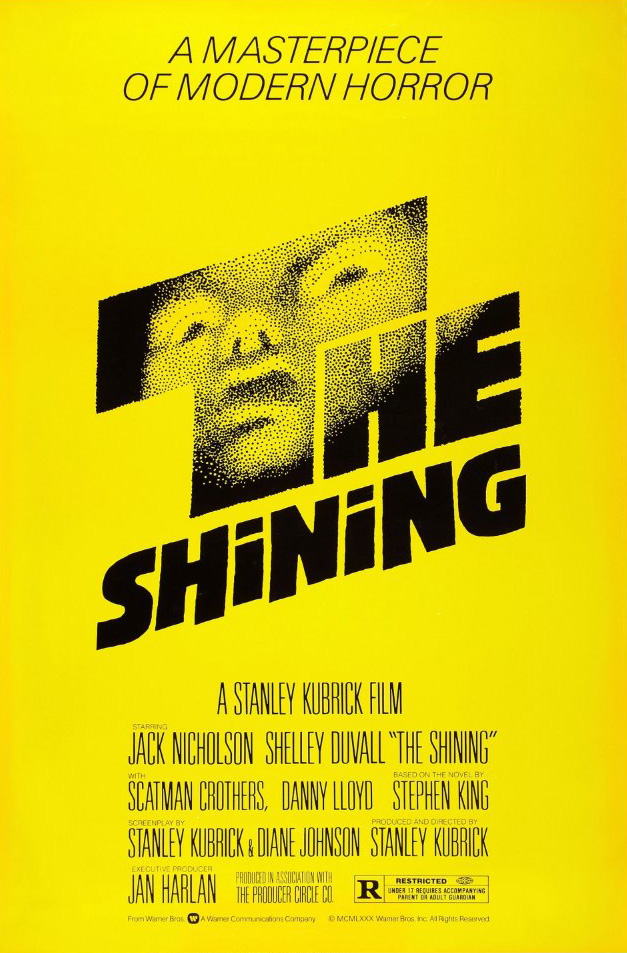Last week, we looked at the Texas Chainsaw Massacre. This week, we go to an extremely well-known example of psychological/suspense horror, the 1980 movie The Shining. Based on a novel from Stephen King, this film was directed by Stanley Kubrick and stars Jack Nicholson and Shelley Duvall as the main couple Jack and Wendy Torrence, as well as Scatman Crothers and Danny Lloyd. The Torrence family (including their young son) travel to a remote hotel for the winter, where Jack will act as caretaker while simultaneously working on a novel. The family soon experiences a variety of threats, both from supernatural forces and from Jack himself.
novel. The family soon experiences a variety of threats, both from supernatural forces and from Jack himself.
One important aspect of this film’s production involves Kubrick’s famously abusive treatment of Shelley Duvall during filming. He reportedly offered her the role before even having the movie’s script, but this favoritism didn’t continue on set; his mistreatment of the actress has been well-documented, and discussed long after the movie was released. Kubrick’s constant “perfectionism” resulted in constantly repeating takes, with many of them taking at least 35 repeats before he was satisfied. Scenes could take up to 3 weeks to complete, which was particularly harmful to Duvall due to the sheer amount of emotional trauma responses required throughout the movie. Stephen King criticized Kubrick’s take on the character as being misogynist; though she was written as an intelligent and fleshed-out character, the director cut out much of her dialogue, reducing her to someone there “to scream and be stupid.” Duvall was kept isolated and often not warned about frightening scenes, such as Torrence breaking a door with an ax– in the film, her scream of fear is a legitimate reaction of surprise. The famous baseball bat confrontation scene took a record breaking 127 takes, which resulted in dehydration, physical injury (from screaming and gripping the bat), and emotional exhaustion. Though she now defends his actions in interviews, many have used this film as an example of historical trends of actresses being mistreated by directors (note this similar event in The Birds).
On a slightly less depressing note, one of the things that made The Shining such a popular movie was its use of newly developed Steadicam technology. It allowed the camera to be stabilized while moving, and was only invented 5 years before the movie came out, making it a relatively new and unseen innovation. One of the most famous uses of this rig occurs in Danny’s tricycle scene, establishing the creepy setting by following him as he rides through the halls of the hotel. Unfortunately, not all of the practical effects were as efficient; since copy-and-paste wasn’t exactly available on a typewriter, Kubrick had his secretary type out the phrase “all work and no  play makes Jack a dull boy” over a thousand times in order to create Torrence’s “manuscript,” which took multiple months.
play makes Jack a dull boy” over a thousand times in order to create Torrence’s “manuscript,” which took multiple months.
In the decades after its release, The Shining has experienced a new wave of popularity, particularly among critics and analysts studying potential messages hidden in its plot and settings. A surprising number of conspiracy theories have arisen regarding Kubrick’s intention with the film; particularly popular theories state that the movie is a metaphor for genocide of indigenous peoples, that it acts as Kubrick’s confirmation of the Apollo 11 moon landing being faked (yes, this is a real theory), that it is meant to represent the tragedy of the Holocaust, or that it is a modern retelling of the tale of Theseus and the Minotaur. Despite these outlandish claims, analyses of The Shining are so extensive and popular that a documentary, called Room 237, was made to summarize and explain them.
As a whole– in a rating that I’m sure would make most horror fans gasp– I would give The Shining a 4/10. Though it’s an incredibly famous movie, and has been the subject of hundreds of deep analyses and studies, I honestly just can’t get into it as much as I’d like. I’ve never considered it particularly scary in any sense, especially compared to other classic horror films like The Thing, and Nicholson’s tendency to over-act definitely ruins the atmosphere of the film for me. However, I would actually still recommend that everyone watches this movie; it may not be my favorite, but its sheer impact on popular culture and psychological horror cannot be understated!
I loved this post! I’m not a huge horror fan, but I like the Shining when I watched it for the first time. I wasn’t aware of the history of the filming at the difference between King’s version and the movie version of Shelly. I agree that I couldn’t get into this horror film as much as other classic ones, but your discussion and interpretation of the movie was great!
I’m not sure if anyone else feels this way, but I think it’s kind of strange to contemplate a King/Kubrick collaboration. “Dr. Strangelove” and even an early King work such as “The Stand” or “The Green Mile” (which was also made into an excellent movie) seem to belong to two very different eras, but “The Shining” is concrete evidence that the two greats weren’t nearly as far apart as I thought.